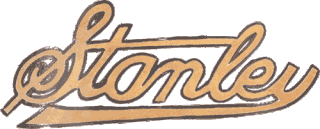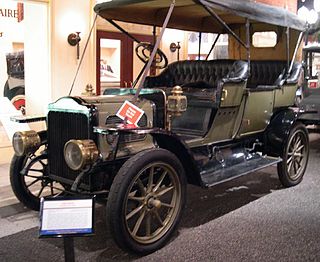Related Research Articles
Lincoln is the luxury vehicle division of American automobile manufacturer Ford. Marketed among the top luxury vehicle brands in the United States, Lincoln was positioned closely against its General Motors counterpart Cadillac. The division helped to establish the personal luxury car segment with the 1940 Lincoln Continental.

The Saxon Motor Car Company was located in Detroit, Michigan, from 1914 to 1922. In 1917, 28,000 cars were made, making it the seventh largest car maker in the United States.

The Stanley Motor Carriage Company was an American manufacturer of steam cars; it operated from 1902 to 1924. The cars made by the company were colloquially called Stanley Steamers, although several different models were produced.
The Ace was an American-assembled car made in Ypsilanti, Michigan by the Apex Motor Car Company, which was reorganized as the Apex Motor Corporation in 1921. The initial batch of cars assembled were sent to Seattle, Washington dealer FE Earnest, who had the idea for the Ace after he was unable to secure a steady supply of new cars for his dealership.
Ambassador was an automobile produced by the Yellow Cab Manufacturing Company of Chicago, Illinois, U.S., between 1921 and 1925.

A steam car is a car (automobile) propelled by a steam engine. A steam engine is an external combustion engine (ECE) in which the fuel is combusted outside of the engine, unlike an internal combustion engine (ICE) in which fuel is combusted inside the engine. ECEs have a lower thermal efficiency, but carbon monoxide production is more readily regulated.

Templar was a manufacturer of automobiles in Lakewood, Ohio from 1917 to 1924. The company was named for the Knights Templar and used a Maltese Cross as an emblem.

The Lexington was an automobile manufactured in Connersville, Indiana, from 1910 to 1927. From the beginning, Lexingtons, like most other Indiana-built automobiles, were assembled cars, built with components from many different suppliers. The Thoroughbred Six and Minute Man Six were popular Lexington models.

The Westcott was an automobile produced in Richmond, Indiana and Springfield, Ohio in the United States between 1909 and 1925 by the Westcott Motor Car Company. The car company was named for its founder, John Westcott.

Barley Motor Car Co. was a manufacturer of automobiles in Kalamazoo, Michigan, and Streator, Illinois. It manufactured the Roamer automobile (1916–29) and, briefly, the Barley (1922–24), and the Pennant (1924–25).
Brooks Steam Motors, Ltd. was a Canadian manufacturer of steam cars established in March 1923. Its cars more closely resembled the Stanley Steamers in terms of engineering rather than the more sophisticated Doble steam cars. The company was formed from the defunct Detroit Steam Motors Corporation.

The Bour-Davis was an American automobile manufactured from 1916 until 1922. The car took its name from two of the founders of the company; Robert C Davis and Charles J Bour. Production of the car was started in Detroit, before moving to Frankfort, Indiana, in 1918. A distinctive feature of the Model 17 and Model 18B cars built in Detroit and Frankfort was the slightly slanted and pointed radiator. Prices ranged from $1250 to $1500 in 1916, rising to $1650 in 1919.
The Sun automobile was made in Elkhart, Indiana from 1916 to 1917, and in Toledo, Ohio from 1921 to 1922.

Gray Marine Motor Company was a U.S. manufacturer of marine engines between 1910 and 1967. These ranged from one to six cylinders in both gas and later diesel layouts, which were used in pleasure boats, work boats, and military craft.

The Cunningham automobile was a pioneering American production automobile, one of the earliest vehicles in the advent of the automotive age. It was produced from 1896 to 1931 in Rochester, New York by James Cunningham, Son and Company.
The Chevrolet Series FB is an American vehicle manufactured by GM's Chevrolet Division from 1919 to 1922. It was a slightly larger replacement to the 1918 Chevrolet Series FA, sitting on a wheelbase of 110 in (2,794 mm) compared to 108 in (2,743 mm). It was replaced by the 1923 Chevrolet Superior.

H. C. S. Motor Car Company was a short-lived Indianapolis, Indiana, automobile manufacturer. It may have built as many as 3,000 cars between the summer of 1920 and 1926, when its doors were closed by its creditors.

The Oldsmobile Light Eight was an automobile produced by the Oldsmobile Division of General Motors in roadster, two-door coupe, four-door sedan form between 1916 and 1923. It was powered by an sidevalve V8 engine, the maker's first, and shared with the 1916 Oakland Model 50.

The Oakland Six was the first six-cylinder engine offered by the Oakland Motor Company in 1913 which became a division of General Motors in 1909. The Oakland Six was offered in many different model names that changed every year, along with several body styles and engine displacements until 1929, when the V8 was reintroduced, then in 1931 Oakland was renamed Pontiac. When Oakland became a division of GM and introduced the Oakland Four, Oldsmobile and Buick shared bodywork and chassis of their six-cylinder models with Oakland. When Chevrolet became part of GM in 1917, Oakland chassis and bodywork were shared with Chevrolet. Manufacture of the Oakland was completed in Pontiac, Michigan.